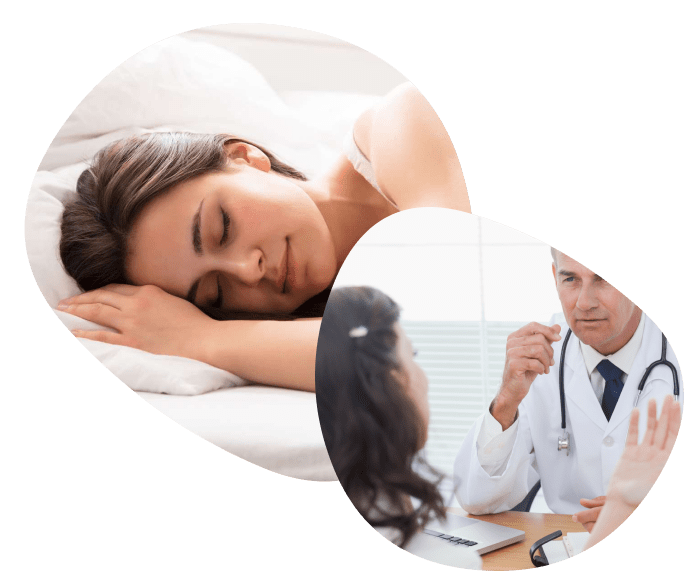A sleep study at home, also known as the HST, enables you to conduct a home sleep study evaluating obstructive sleep apnea, directing a pathway for enhanced diagnosis and potent treatment options. A conventional sleep study test is traditionally performed at a sleep lab. A home sleep test aims to monitor and record sleep parameters such as oxygen levels or breathing patterns, providing insights into sleep disorders for reliable diagnosis and productive treatment options.
Home Sleep Study
A home sleep study test allows convenient sleep testing in the comfort of your home, unlike traditional in-lab testing, which requires overnight testing at a sleep center.
iSleep Physicians Group
Sleep Study at Home—Defined
Sleep apnea is a disorder marked by shallow breathing and disruptive or fragmented sleep. Home Sleep Test requires a device for sleep testing within the comfort of the home, providing great convenience and ease. In comparison to in-lab test, a home sleep test is a cost-effective approach with accurate results.
Any reusable parts like the belt, oximeter, and HST unit must be sanitized between different home sleep study uses. Assuming you have acrylic, plunge, or applied ("counterfeit") nails, record fingernails should be eliminated for oxygen perusing. The polish from one of your index fingers must be removed if you have gel nail polish. The oximeter cannot read gel polish or acrylic applied. The specific sleep study equipment and protocols utilized by the sleep center or healthcare provider overseeing the study may affect the Sleep Study at Home.


Sleep Study at Home
Understanding the Role of Home Sleep Test
iSleep Physicians Group
What are the signs of OSA?
Obstructive sleep apnea (OSA) is a problem portrayed by rehashed breathing interferences during sleep. Signs and side effects of OSA include:
01 Excessive daytime sleepiness
02 Morning headaches
03 Nighttime urination
04 Restless sleep and insomnia
05 Excessive gasping or choking during sleep
06 Irritability and mood changes
07 Dry mouth or sore throat upon waking
It is essential to note that the severity of these signs and symptoms can vary from person to person and that not everyone with OSA exhibits all of them. Talking with medical services proficiently and going through a home sleep study is vital for a legitimate finding and proper therapy.
iSleep Physicians Group
What are the risks of untreated OSA?
High blood pressure, irregular heart rhythms, and an increased risk of heart disease, stroke, and heart attacks can all result from untreated OSA. The divided and low-quality sleep brought about by OSA can bring about daytime sluggishness, diminished mental capability, trouble thinking, and debilitated execution in day-to-day exercises, including work and driving. Untreated OSA can deteriorate other ailments like diabetes, and asthma, making it harder to deal with these circumstances. Additionally, it may contribute to the onset or escalation of mental health issues like anxiety and depression.


iSleep Physicians Group
Difference Between a Home Sleep Study and an In-Lab Sleep Test
A portable device that monitors the sleep parameters during sleep is the cornerstone of a home sleep study conducted from the privacy of the home. The device can measure oxygen levels, breathing patterns, and the variation in heart rate. Compared to a conventional sleep study, the HST device is easy to use and less intrusive. Even though HST allows convenient testing and enables better sleep provided a familiar environment, the data collected is selective and limited.
On the contrary, polysomnography happens in a sleep lab center, where patients sleep overnight in a monitored environment. In addition, multiple sleep parameters can be examined within a night. Spanning from brain waves, eye movements, and muscle activity to heart rate or airflow, a trained technician records all the necessary parameters by attaching various sensors. The extensive data collected allows detection of the severity of sleep apnea. Additionally, an in-lab test provides for the diagnosis of other sleeping disorders.
Do I Need a Home Sleep Test?
A healthcare professional, such as a sleep specialist or a sleep medicine specialist, should determine whether you require a home sleep study. They will note your symptoms, medical history, and any relevant risk factors to determine whether you require an in-lab or home sleep study.
How do I set up the HST equipment?
Follow the instructions carefully to set up the home sleep test (HST) equipment. Follow the instructions to attach the sensors, such as the airflow sensor and finger clip. Start the recording before bed, sleep as usual, and stop it when you wake up to ensure the device is working properly. You should talk to your doctor during the setup if you have any questions or concerns.


iSleep Physicians Group
What Happens After a Home Sleep Test?
After completing a home sleep test, you return the device to your healthcare provider. Our sleep specialist analyzes the recorded data, interprets the results, and suggests proper treatment options for the future. It is essential to schedule a follow-up appointment with a sleep expert or opt for an online post-test consultation with our certified experts to discuss the next steps in managing your sleep health.
iSleep Physicians Group
How is OSA treated?
Oral appliances, which keep the throat open, lifestyle changes like losing weight and using positional therapy, and sometimes surgery to fix anatomical problems that cause airway obstruction are other options for treating OSA. In consultation with a medical professional, the most effective treatment for OSA will be determined by the severity of the condition and individual factors.


Love to hear from you,
Get In Touch
We are always here to sort out concerns, share valuable information, or hear from you. Contact us!
